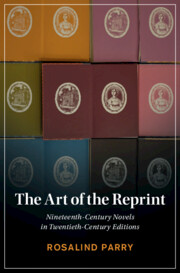Book contents
- The Art of the Reprint
- Cambridge Studies in Nineteenth-Century Literature and Culture
- The Art of the Reprint
- Copyright page
- Dedication
- Contents
- Figures
- Acknowledgments
- Introduction
- Chapter 1 Clare Leighton & Thomas Hardy’s The Return of the Native
- Chapter 2 Rockwell Kent & Herman Melville’s Moby Dick
- Chapter 3 Fritz Eichenberg & Charlotte Brontë’s Jane Eyre
- Chapter 4 Joan Hassall & The Complete Novels of Jane Austen
- Coda
- Notes
- Bibliography
- Index
- Cambridge Studies in Nineteenth-Century Literature and Culture
Chapter 4 - Joan Hassall & The Complete Novels of Jane Austen
Published online by Cambridge University Press: 23 March 2023
- The Art of the Reprint
- Cambridge Studies in Nineteenth-Century Literature and Culture
- The Art of the Reprint
- Copyright page
- Dedication
- Contents
- Figures
- Acknowledgments
- Introduction
- Chapter 1 Clare Leighton & Thomas Hardy’s The Return of the Native
- Chapter 2 Rockwell Kent & Herman Melville’s Moby Dick
- Chapter 3 Fritz Eichenberg & Charlotte Brontë’s Jane Eyre
- Chapter 4 Joan Hassall & The Complete Novels of Jane Austen
- Coda
- Notes
- Bibliography
- Index
- Cambridge Studies in Nineteenth-Century Literature and Culture
Summary
In Chapter 4 explores Joan Hassall’s (1906–88) illustrations for The Folio Society’s editions of Jane Austen’s novels and stories. Completed between 1957 and 1963, and then added to in 1975, these editions tend to be criticized for blending too seamlessly into Austen’s novels. Hassall, whose style was anachronistic in the 1950s through the 1970s but fittingly like that of Austen’s time, can seem (and has been described as) apolitical, unassertive, and small, descriptors that were once negatively applied to Austen. Hassall took a craft-based ownership of the Austen canon, finding the author in even the smallest of notches and grooves of her engravings. She collected, for example, scraps of ribbons and fabrics from the Georgian era, which she then copied and traced onto her woodblocks and patterned onto the covers, frontispieces, and chapter headings of her Austen editions. Hassall is less reinventing the nineteenth-century novel than retracing and reinhabiting it. Yet she, like the other artists in this book, invested an enormous amount in her readings of the novels, not just in the details of her images, but in the labor of engraving itself, which she did despite nearly crippling arthritic pain.
Keywords
- Type
- Chapter
- Information
- The Art of the ReprintNineteenth-Century Novels in Twentieth-Century Editions, pp. 124 - 153Publisher: Cambridge University PressPrint publication year: 2023

